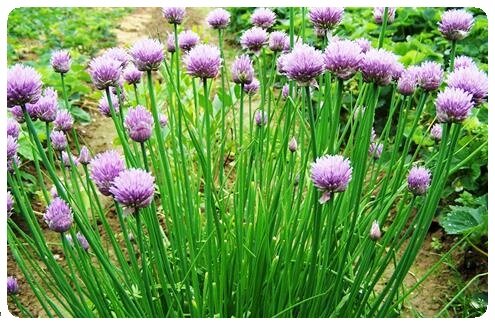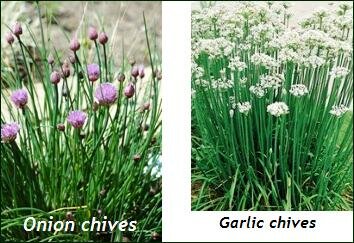Growing Chives
Useful and nutritious, chives speak mountains as a garnish. With a snip, snip and scatter, they can turn a pile of mashed something into a masterpiece.

Chives, like onions, leeks, garlic and scallions are from the Allium family. Chives are perennials and in temperate or cold climates they will die down and re-emerge each spring.
They have a mild, delicate flavour... and no kitchen could possibly be called a proper kitchen without have some chives to use with food!
Chives are happy just about anywhere. Allot a small patch of your garden to growing chives; or like me, have a bunch here, a bunch there and some more over there.
Grow them in a pot inside or out; your chives will thrive.
Best climate for growing chives
Chives honestly don't care too much about nasty conditions such as freezing, rain, wind and so on. But they really thrive in a hot sunny place in summer.
Also if you are in a temperate or cold climate, make sure to cut the leaves and any flower stalks right down to a few cms from ground level at the beginning or middle of winter. In early spring, feed and divide and replant if necessary and your chives will produce lovely fat new leaves.
If you are growing chives in warmer areas, your plants will keep producing all year round as long as you feed them and occasionally divide the clumps. Giving the plants a trim now and then also helps keep them growing through the years.
When to plant chives
Springtime is perfect. You can use both seeds and bulbs to grow chives. Seeds will be slower and not produce much in the first year. It's a better idea to use bulbs if you want to get them off to a head start.
Chive varieties

When growing chives, you can choose from several varieties, the main ones being:
- The common garden onion chive (Allium schoenoprasum) which has a taste similar to mild onions. They have tubular leaves and pink flowers.
- Chinese or garlic chives (Allium tuberosum) which have a garlic-like flavor and have flat leaves with white flowers.
Growing chive seeds and seedlings
For seeds, make sure they are fresh as their germination rate is not good if more than a year old. Sprinkle lightly over the soil and water in. Cover with a fine layer of soil and keep damp.
When growing from young seedlings, take a bunch of about five bulbs and plant them at a distance of 10cms (4") from each other so that the tips are level with the ground surface. You can grow them in rows or groups in your garden or in flower pots indoors on a window sill.
Every two-3 years its best to divide chives otherwise they seem to get all lovey dovey and tangle and strangle each other in a solid sulking clump. Simply dig out a clump until it's free of the soil. You'll find multiple bulbs clumped together. Just separate them and plant each bulb separately or a small group of bulbs in a new spot. They'll soon begin to thrive on their own.
Soil preparation before growing chives
Chives being hardy members of the onion family can survive and grow in any soil provided it is well-drained and has a pH range between 6.0 and 7.0.
If you plant your chives in a humus rich, moisture-holding little patch of soil, you'll be enjoying their bounty for your kitchen in no time.
Nutrient requirements for growing the best chives
For continuous harvesting, don't let plants get too dry and put a small layer of compost or other fertilizer around them in spring. Do this again in mid-summer, or give them monthly liquid fertilizer.
Harvesting chives
Wait until the chives grow several inches and keep harvesting the parts as and when required. Start with picking the thickest leaves and then the outermost leaves and work inwards. Scissors are handy for this... use sharp scissors to cut chives about 5cm (2") above the soil, harvesting from the outside edges of the clumps.
Don't harvest all the leaves in one go. Leave about 5cm of leaves on the plant and you'll soon notice that they grow back.
Chives are always determined to flower and you must be just as determined to stop this, at least to some extent. Mostly you want the growing energy to go into leaves not flowers... but the flowers are sweet and edible, the bees love them and you'll get lots of seeds to scatter around or give to friends.
So snip off most of the emerging flower buds and leave the odd few, or alternatively try a clump or two of growing chives elsewhere to flower for attracting bees and for edible and ornamental use.
Sometimes with growing chives, you may find the plant drying up and looking a bit weak. All you need to do is cut the leaves a little and trim off all dead stalks. This will rejuvenate the plant which will soon start putting out new leaves.
Chives pests and diseases
Chives are just about disease free and the only pests of any problem are thrips. These can start off as one or two, but be careful as overnight they explode into a mass chive feast. They look like small black aphids, and like aphids these thrips will suck the sap from your chive leaves and ultimately kill the plant.
Rub the first few thrips off with your fingers and you'll usually fix the problem, but if not give them an organic spray or use the garlic spray at: Organic Pest Control.
Eating and storing Chives
Being a member of the Allium family, chives have a mild onion flavor. Certain varieties, such as garlic chives (Allium tuberosum) feature flat leaves with an intense flavor that is pungent enough to replace a regular garlic clove in most recipes.
Chives don't store well, it's best to pick them just before using. Any leftovers, put in plastic bag and keep in fridge.
Don't eat the little bulbs, they are unpleasant. Chive flowers are edible, and always follow a burst of spring growth. Both the leaves and flowers provide an excellent garnish and a colorful addition to salads, eggs, potatoes, soups, and fish.
Now you are an expert on growing chives, check out more herbs to grow: Growing Herbs





